
The American Gold Eagle is an official gold bullion coin of the United States. Authorized under the Gold Bullion Coin Act of 1985, it was first released by the United States Mint in 1986. Because the term "eagle" also is the official United States designation for pre-1933 ten dollars gold coins, the weight of the bullion coin is typically used when describing American Gold Eagles to avoid confusion. This is particularly true with the 1/4-oz American Gold Eagle, which has a marked face value of ten dollars.

Britannia coins are British bullion coins issued by the Royal Mint in gold since 1987, in silver since 1997, and in platinum since 2018. The reverse of the coin patterns feature various depictions of Britannia, a feminine personification of the United Kingdom while the obverse features a monarch effigy with the legend around it.
The Australian Gold Nugget, also sometimes known as the Australian Gold Kangaroo, is a gold bullion coin minted by the Perth Mint. The coins have been minted in denominations of 1⁄20 oz, 1⁄10 oz, 1⁄4 oz, 1⁄2 oz, 1 oz, 2 oz, 10 oz, and 1 kg of 24 carat gold.

The Manx Noble are platinum, gold or silver bullion coins distributed by the Isle of Man and minted by private companies. While platinum coins have been minted since the early 1800s, the Noble is the first platinum coin created for investors. The coins are not minted every year, but have an erratic schedule. Nobles are legal tender but they do not have a fixed face value; instead, like the Krugerrand or Mexico's Libertad, they are legal tender to the value of their precious metal content.

The Chinese Silver Panda is a series of silver bullion coins issued by the People's Republic of China. The design of the panda is changed every year and minted in different sizes and denominations, ranging from 0.5 troy oz. to 1 kilogram. Starting in 2016, Pandas switched to metric sizes. The 1 troy ounce coin was reduced to 30 grams, while the 5 troy ounce coin was reduced to 150 grams. There is also a Gold Panda series issued featuring the same designs as the Silver Panda coins.
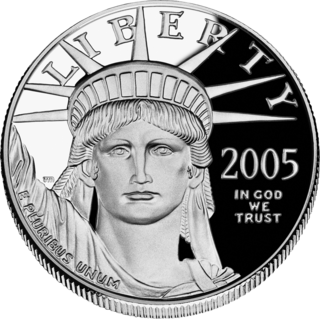
Platinum coins are a form of currency. Platinum has an international currency symbol under ISO 4217 of XPT. The issues of legitimate platinum coins were initiated by Spain in Spanish-colonized America in the 18th century and continued by the Russian Empire in the 19th century. As a form of currency, these coins proved to be impractical: platinum resembles many less expensive metals, and, unlike the more malleable and ductile silver and gold, it is very difficult to work. Several commemorative coin sets have been issued starting from 1978 and became popular among coin collectors. The major platinum bullion coins include the American Platinum Eagle, the Canadian Platinum Maple Leaf, the Australian Platinum Koala, the Isle of Man Noble, the Chinese Platinum Panda, the Austrian Vienna Philharmonic and several series by the Soviet Union and later by the Russian Federation.
The Canadian Silver Maple Leaf is a silver bullion coin that is issued annually by the Government of Canada since 1988. It is produced by the Royal Canadian Mint.
The coins of the Australian dollar were introduced on 14 February 1966, although they did not at that time include the one-dollar or two-dollar coins. The dollar was equivalent in value to 10 shillings in the former currency.
The Australian penny was a coin of the Australian pound, which followed the £sd system. It was used in the Commonwealth of Australia prior to decimalisation in 1966. One Australian penny was worth 1⁄12 Australian shilling, 1⁄24 Australian florin, 1⁄60 Australian crown, and 1⁄240 Australian pound. The coin was equivalent in its dimensions and value to the British pre-decimal penny, as the two currencies were originally fixed at par.

The Australian pre-decimal halfpenny coin, commonly known as a ha’penny, was the smallest denomination of the Australian Pound in circulation. It was a unit of currency that equalled half of a penny, 1/24 of a shilling, or 1/480 of a pound. The coin was made to be equivalent to the British halfpenny; its dimensions, composition and values were equivalent, and additionally, the two currencies were fixed at par.
The Standard Catalog of World Coins is a series of numismatic catalogs, commonly known as the Krause catalogs. They are published by Krause Publications, a division of Active Interest Media.

The Silver Kookaburra is a silver bullion coin originating from Australia, and produced at the Perth Mint starting in 1990. The coins were .999 fine silver until the 2018 edition, which increased in purity to .9999 silver. While the obverse of the coin always depicts Queen Elizabeth II, the reverse side changes every year, always featuring a kookaburra, a bird native to Australia. Due to the yearly design change and limited production of the one-ounce coins, they have higher collectible value than some other bullion coins. The Perth Mint generally ships the coins in individual plastic capsules. One-ounce coins ship in shrink wrap rolls of 20, with 5 rolls in each box of 100. They are minted in four sizes; 1000g, 10, 2 and 1 troy ounces.
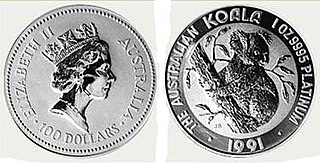
The Platinum Koala is an Australian platinum bullion coin minted by the Perth Mint between 1988 and 2000. The Platinum Koala is notionally legal tender, that is a legal means of payment.
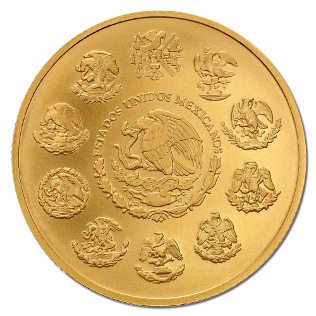
The Libertad coins are silver and gold bullion coins originating from Mexico and minted by the La Casa de Moneda de México. The Mexican Mint was established in 1535 and is the oldest mint in the Americas. The modern coins contain 99.9% silver or gold and are available in various sizes. Both metal coins have undergone a design change. In 1989, 3,500 1⁄4 ounce Libertad platinum coins were produced. Libertads are devoid of face value, yet are legal tender, still accepted as currency and guaranteed by Banco de México based on the market value of its gold or silver content.

The Chinese Gold Panda is a series of gold bullion coins issued by the People's Republic of China. The Official Mint of the People's Republic of China introduced the panda gold bullion coins in 1982. The panda design changes every year and the Gold Panda coins come in different sizes and denominations, ranging from 1⁄20 to 1 troy ounce.
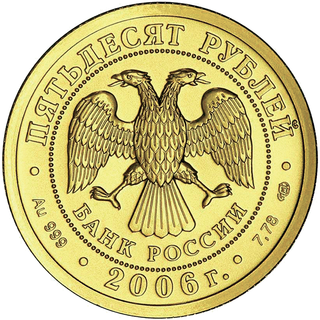
The Russian George the Victorious is a bullion coin issued in gold and silver by the Central Bank of Russia. Mintage began in 2006 with quarter-troy ounce (7.78g) gold coins with a face value of 50 rubles and later in 2009 a one-troy ounce silver coin was introduced with a face value of 3 rubles. Since then, tenth, half, and one-troy ounce gold coins have been minted.

The Korean Tiger Bullion Series Medal is a series of gold bullion medals issued by the Korean Minting, Security Printing & ID Card Operating Corporation (KOMSCO). The first series was introduced in June 2016. The medals are minted in the following denominations of 1/4 oz, 1/2 oz, and 1 oz of 99.99% of fine gold.
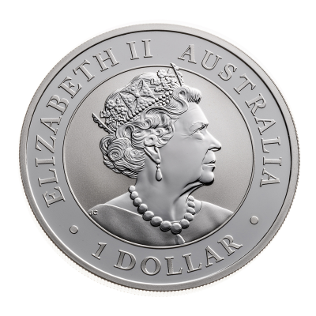
The Silver Koala Bear is a silver coin originating from Australia and produced at the Perth Mint. While the obverse of the coin always depicts Queen Elizabeth II of Australia, the reverse side changes every year, always featuring a koala, a marsupial native to Australia.

The Archangel Michael are silver and gold bullion coins originating from Ukraine and minted by the National Bank of Ukraine.

Manx Angels are gold or silver bullion coins distributed by the Isle of Man and minted by private companies. The Isle of Man is not part of the United Kingdom. It is a Crown dependency and thus can mint its own coins. The coin depicts Archangel Michael slaying a dragon. The silver coins have not been minted every year, but have an erratic schedule. Angels are legal tender but they do not have a fixed face value; instead, like the Krugerrand or Mexico's Libertad, they are legal tender to the value of their precious metal content.
















